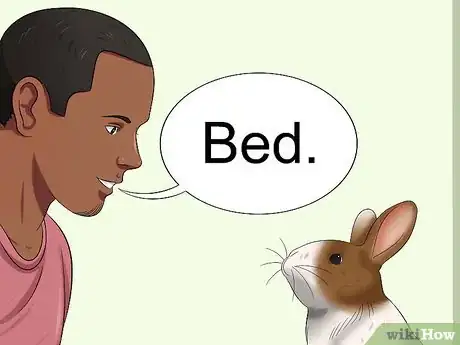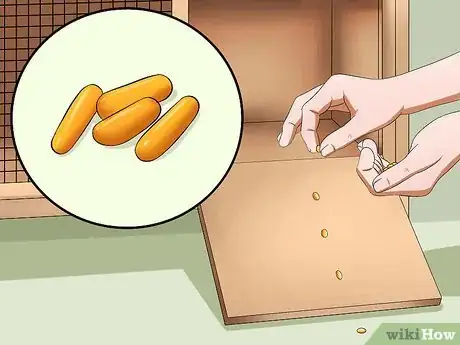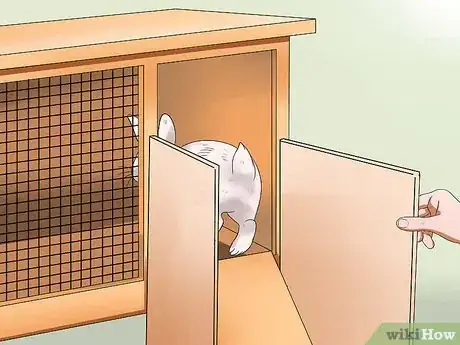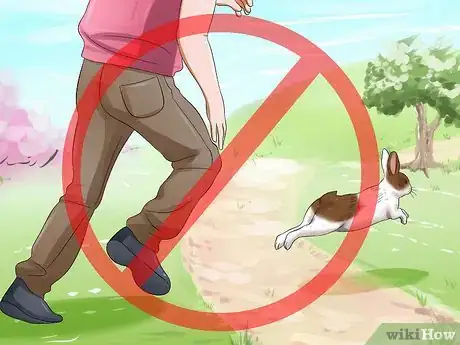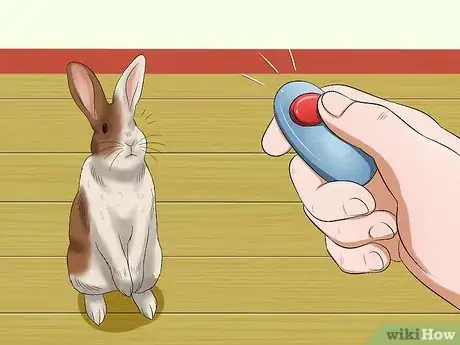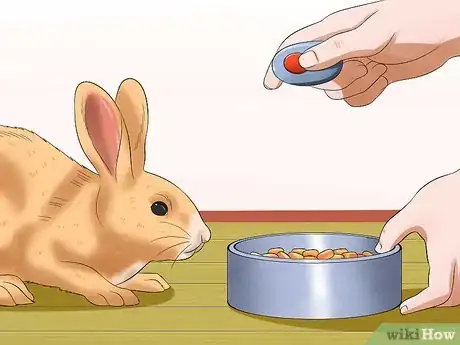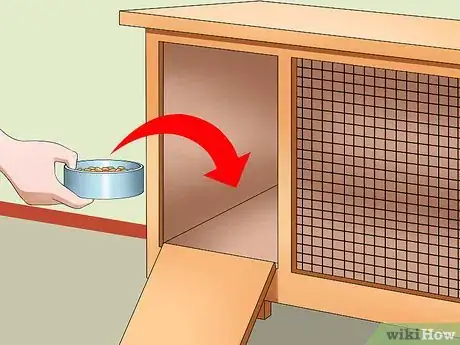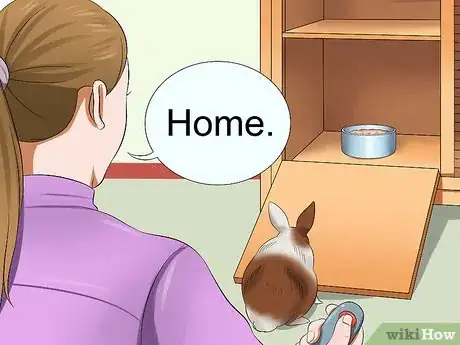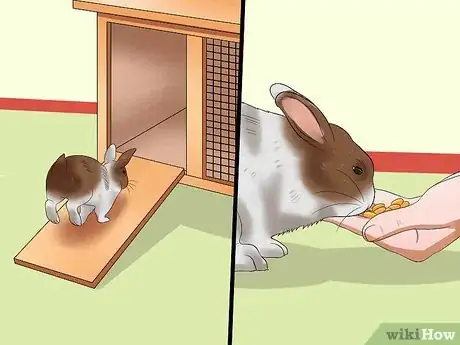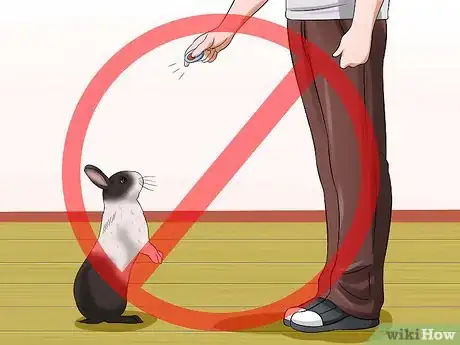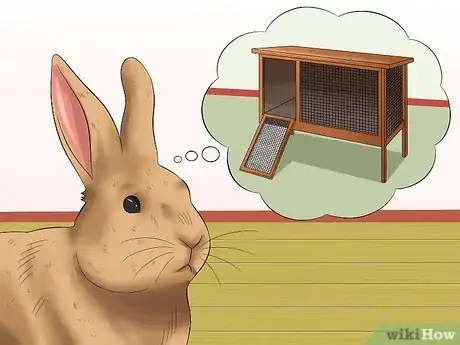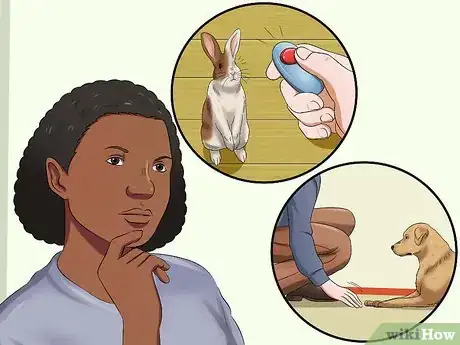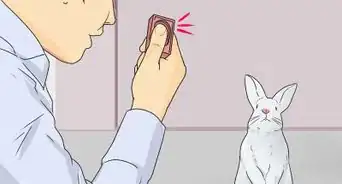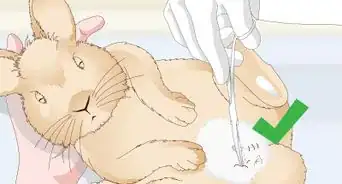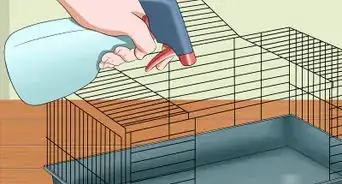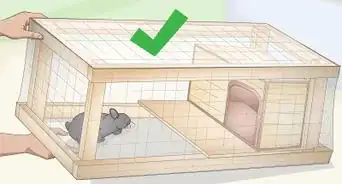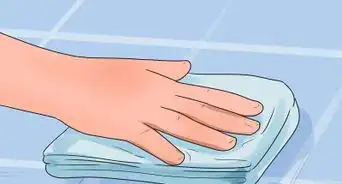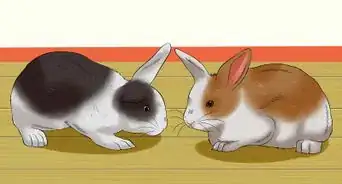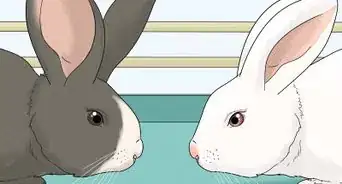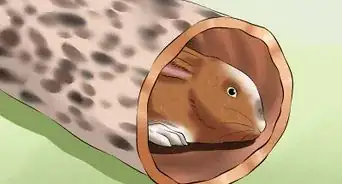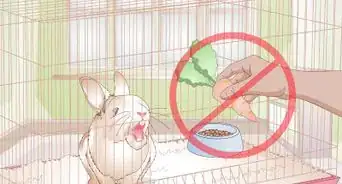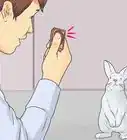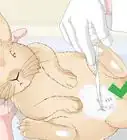This article was co-authored by Pippa Elliott, MRCVS. Dr. Elliott, BVMS, MRCVS is a veterinarian with over 30 years of experience in veterinary surgery and companion animal practice. She graduated from the University of Glasgow in 1987 with a degree in veterinary medicine and surgery. She has worked at the same animal clinic in her hometown for over 20 years.
This article has been viewed 57,738 times.
Are you having trouble getting your rabbit to go back into his hutch? Ideally, your rabbit’s hutch should be a place of safety and security for him. However, if the hutch doesn’t feel safe to him, or he really enjoys being outside of the hutch, it may take some calm and gentle coaxing to convince your rabbit to go back into it.[1] Do not be surprised or frustrated if it takes a lot of time and patience (and treats!) to teach your rabbit to go back into his hutch. No need to worry, though—your rabbit is very intelligent and will eventually understand what you want him to do.[2]
Steps
Teaching Your Rabbit to Go Back Into Hutch Without a Clicker
-
1Choose a verbal command. You can teach your rabbit to go back into his hutch with or without a clicker. With either method, a verbal cue will be helpful. Choose a short, simple cue like ‘home’ or ‘bed.’ You will need to say this cue each time you want your rabbit to go back into his hutch.[3]
- Whenever you say the cue, say it in a quiet yet clear and confident voice.
- Say the cue without emotion. Even if you are frustrated with your rabbit, that frustration should not be apparent when you say the cue.
-
2Guide your rabbit back into his hutch with treats. Small pieces of fresh apple, carrots, or melons make great treats for rabbits. Place a small handful of treats in your rabbit’s hutch, making sure he can see you do it.[4] The treats serve as an incentive for your rabbit to return to his hutch.
- If your rabbit does not want to walk all the way to the hutch to get the treats, make a trail of treats leading to the hutch.[5] This way, he can munch on something on tasty when he walks toward and into the hutch.
- Say your verbal cue as your rabbit walks towards and into the hutch. This will allow him to associate the cue with returning to the hutch, and learn that the cue is followed by a tasty treat.
Advertisement -
3Build a chute towards your rabbit’s hutch. With a chute, you are giving your rabbit only one way of getting back to his hutch without the opportunity to escape. Fortunately, you do not have to spend a lot of money (or any money) to make the chute. Place a series of cardboard boxes on two sides to create an enclosed pathway through which your rabbit will walk to reach his hutch.[6]
- Place some tasty treats in his hutch so your rabbit will be rewarded when he goes inside of it.[7] Consider placing treats along the chute’s pathway as well.
- When your rabbit is in the chute, block the entryway so he cannot escape.[8]
- As your rabbit walks through the chute, stay a few feet behind him and repeat your verbal cue until he reaches his hutch.[9]
- You may need to place your rabbit inside of the chute—he may not go in there willingly.
- If your rabbit is showing signs of distress or fear (e.g., stomping feet, grunting), break down the chute and try again later on.[10]
-
4Do not chase your rabbit or move quickly. If your rabbit is already reluctant to go back into his hutch, chasing him or trying to get him back into the hutch quickly will not work. In fact, either of those activities may frighten your rabbit and make it even harder for your rabbit to do what you want him to do.[11] Even if your rabbit is testing your patience, do your best to move slowly and calmly, and keep a small distance away from your rabbit.
Using a Clicker to Get Your Rabbit Back Into the Hutch
-
1Introduce your rabbit to the sound of the clicker. Clicker training is another effective way to teach your rabbit to go back into his hutch. First, your rabbit will need to get comfortable with the clicker’s sound and learn what the sound means. In a quiet, distraction-free area of your home, press down on the clicker. Wait for a second or two, then give your rabbit a treat.
- Clickers are available at your local pet store. You can also use a writing pen or mechanical pencil as a clicker.
- The time gap between using the clicker and giving your rabbit a treat allows him to hear and pay attention to the clicker.
- Continue using the clicker with a pause until your rabbit looks to you expectantly for a treat when he hears the click. Rabbits learn at different paces, so it may take a lot of repetition before your rabbit associates the click with a treat.[12]
- You can challenge your rabbit by using the clicker when he is busy doing something else, like playing with a toy. If he turns to you looking for a treat when he hears the click, you will know that he understands what the click means. Reward him with a treat.
- The sound of a click may be frightening to a timid rabbit. To avoid frightening your rabbit, place your clicker in a pocket or gloved hand to muffle the sound.[13]
-
2Place a bowl of treats in your rabbit’s exercise area. When your rabbit can associate the click with a treat, use the clicker to teach him to go back into his hutch. Put a few tasty treats in a small bowl and position the bowl where he exercises and plays. Immediately click and give him a treat if he looks at the bowl or makes any movement towards the bowl.
- If he moves toward the bowl, click and give him a treat just before he reaches the bowl.
- Start by placing your rabbit near the bowl, then slowly place him further and further away from it. The goal is to teach him to move towards the bowl from any direction (and any distance) in his exercise area. Continue to use the clicker and give him a treat as before.
-
3Move the bowl of treats into your rabbit’s hutch. When your rabbit is comfortable moving towards the bowl, place it inside of his hutch, near its entrance. Place your rabbit near the bowl as you did before, and slowly increase the distance between your rabbit and the bowl. Immediately click and give your rabbit a treat as you did previously.
- The goal for this step is to encourage your rabbit to go into the hutch from any direction and distance within his exercise area.
-
4Add in the verbal cue. Verbal cues are important during clicker training. Watching your rabbit’s movements closely, say the verbal cue right before your rabbit begins to walk toward the bowl in his hutch.[14] Saying the cue before your rabbit moves helps him understand why you are saying the cue in the first place.
- You may have to repeat the cue many times before he reaches this understanding.
-
5Challenge your rabbit. Now that you have added in the verbal cue, remove the food bowl from your rabbit’s hutch. This will challenge him to go back into his hutch even when there is no bowl of treats waiting for him. When he goes inside his hutch after you give your verbal cue, immediately click and give him a treat from your hand.
-
6Stop using the clicker. In addition to removing the food bowl from your rabbit’s hutch, you should also stop using the clicker. By the end of your training, your rabbit should be able to respond to only your verbal cue to return to his hutch.
Learning Basic Tips for Training Rabbits
-
1Let your rabbit think it was his idea to go in the hutch. It may be tempting to teach your rabbit to go back into his hutch by forcing him into it. However, using force indicates that going back into the hutch is your idea. He will be more likely to return to his hutch if you let him think it was his idea to do so.[15]
- Creating a trail of treats and leaving a bowl of treats in the hutch will help your rabbit think that it’s his idea to return to his hutch.
-
2Learn how training a rabbit is different from training a dog. Like dogs, rabbits enjoy receiving rewards. However, rabbits do not aim to please as dogs do. In the wild, rabbits did not evolve to be very cooperative with each other unless there was an outside threat.[16] Since wild rabbits do not necessarily look up to their leaders, it is not surprising that your own rabbit does not have much incentive to look up to you and please you.[17]
- To train your rabbit, keep in mind that he is not trying to please you. Rather, he is primarily looking for his reward.
-
3Do not punish your rabbit. As with other pets, punishment is not effective with rabbits. Verbal and/or physical abuse will cause your rabbit to see you as the bad guy. In addition, punishment can lead to negative behavioral changes in your rabbit—he may become afraid, withdrawn, or even aggressive.[18]
- If you sense yourself become frustrated with your rabbit, it may be time to end your training session and try again later.
Warnings
References
- ↑ http://animals.mom.me/cant-rabbit-back-his-cage-1289.html
- ↑ http://www.rabbitmatters.com/rabbit-training.html
- ↑ http://animals.mom.me/cant-rabbit-back-his-cage-1289.html
- ↑ http://animals.mom.me/cant-rabbit-back-his-cage-1289.html
- ↑ http://animals.mom.me/cant-rabbit-back-his-cage-1289.html
- ↑ http://animals.mom.me/cant-rabbit-back-his-cage-1289.html
- ↑ http://animals.mom.me/cant-rabbit-back-his-cage-1289.html
- ↑ http://animals.mom.me/cant-rabbit-back-his-cage-1289.html
- ↑ http://animals.mom.me/cant-rabbit-back-his-cage-1289.html
- ↑ http://animals.mom.me/cant-rabbit-back-his-cage-1289.html
- ↑ http://animals.mom.me/cant-rabbit-back-his-cage-1289.html
- ↑ http://www.clickertraining.com/node/306
- ↑ http://www.trianglerabbits.org/behavior/clicker_training.html
- ↑ http://www.trianglerabbits.org/behavior/clicker_training.html
- ↑ http://animals.mom.me/cant-rabbit-back-his-cage-1289.html
- ↑ http://www.bio.miami.edu/hare/training.html
- ↑ http://www.rabbitmatters.com/rabbit-training.html
- ↑ http://www.rabbitmatters.com/rabbit-training.html
- ↑ http://www.rabbitmatters.com/rabbit-training.html
- ↑ www.rabbit.org/care/Teaching%20Kids%20About%20Rabbits.pdf
- ↑ www.rabbit.org/care/Teaching%20Kids%20About%20Rabbits.pdf
About This Article
If you want to teach your rabbit to go back to its hutch, start by choosing a short, simple verbal command like "home" or "bed" and use the same command consistently to prevent any confusion. Next, say the command in a clear, confident, and emotionless tone of voice. Then, hold out treats, like small pieces of fresh apples, carrots, or melons, to guide your rabbit back to its hutch. If your rabbit won't follow you, try creating a trail of treats instead. Continue repeating the verbal command as you guide your rabbit and be sure to put some tasty treats inside the hutch as a reward! For tips from our Veterinary co-author on using a clicker for training, read on!
